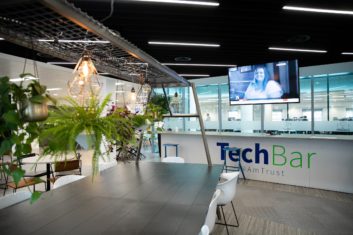As definitions go, it would be fair to say that managed services – to paraphrase iconic American poet Walt Whitman – ‘contains multitudes’. Even as the term has been significantly more commonplace in professional AV, it has also become increasingly clear that it is unlikely to accrue one concise definition.
That being said, it is possible to make a few, hopefully not too sweeping, generalisations. In the vast majority of cases, managed services involve a company or organisation outsourcing responsibility for specific AV-related equipment and tasks to a specialist third party. This will often be arranged on a defined-duration contract basis, although there may be scope for the specialist’s remit to change and expand over time. And where once there may have been a tendency to focus on periodic system health-checks and software upgrades, there is now more of an emphasis on continual monitoring and maintenance – making it easier for potential problems to be detected before they can have a negative impact.
 As the perceived convergence between AV and IT infrastructures has developed, an IT element to AV-oriented managed services has also become more habitual. Most recently of all, the pandemic has led to a “marked uplift” in demand for services that can remotely manage high-quality video communications, says Visavvi head of collaboration Chris Rawden: “We are seeing a lot of people waking up to the potential of hybrid solutions and wanting to ensure that their rooms are video-enabled and can be remotely managed and maintained.”
As the perceived convergence between AV and IT infrastructures has developed, an IT element to AV-oriented managed services has also become more habitual. Most recently of all, the pandemic has led to a “marked uplift” in demand for services that can remotely manage high-quality video communications, says Visavvi head of collaboration Chris Rawden: “We are seeing a lot of people waking up to the potential of hybrid solutions and wanting to ensure that their rooms are video-enabled and can be remotely managed and maintained.”
DYNAMIC PANDEMIC
All of which means that managed services has continued to be pretty dynamic throughout the pandemic, and is expected to become even more so as remote and hybrid working practices become more widespread and well-defined. Perhaps inevitably, this is already leading to a new generation of service packages aimed at different corporate levels and requirements.
For AV solutions provider and integrator Visavvi, a key focus of its recent managed services activity has proven to be especially timely given the increased need for trouble-free meeting, collaboration and video conferencing facilities. Developed in-house by Visavvi, Vantage is a subscription-based service providing organisations with intelligent 24/7 remote monitoring of workplace technology. Making it possible to monitor every aspect of a company’s AV environment – not least its conferencing and collaboration infrastructures – Vantage ensures that “our engineers will always be the first to know if and when something goes wrong,” says Rawden.
EXTERNAL EMPHASIS
Whilst the service brings with it an emphasis on external management, it also provides flexibility for the customer itself to take on responsibilities with which it is comfortable. “We have different levels of administration with Vantage, so customers can log-in and manage the system themselves or have us manage it for them. The focus is very much on making Vantage as easy to use and deploy as possible,” notes Rawden.
There is no doubt that the value of a system that can support extensive remote fault detection has been reinforced by the pandemic. The ability to “remotely and securely access a customer’s AV facilities via Vantage allows our engineers to resolve many issues without making a physical visit to the site,” explains Rawden. “This substantially increases immediate fault resolution and reduces system downtime. Of course, in those scenarios where an issue is discovered that cannot be resolved remotely, we can ensure the prompt arrangement of an onsite visit by an AV service and maintenance engineer.”
Looking forward to the post-pandemic era, Rawden anticipates increased demand for Vantage as customers’ requirements of collaboration become more defined. “Even in the last few months we have seen a huge rise in the number of people using Office 365 and Teams, and getting to grips with more of the features they offer,” he says. With a majority of meetings likely to have an external contributory element, “there is going to be a lot of emphasis on people being able to have the same experience and access to the same features, whether they are sitting there in the room or are located remotely.”
In this context Rawden asserts that there is “already a trend towards more simply configured” meeting and collaboration solutions that can be deployed on-premise or at participants’ homes. In the same technological ballpark, “the number of requests for BYOD has also gone up – and that’s not just for small spaces, but larger environments as well. For example, you might have a Teams or Zoom-based system in a room that is being remotely monitored and managed, but then the customer decides that they also require a level of BYOD capacity and different laptops are using different services. That can lead to a situation where you have various platforms not talking to each other properly, so I think there will need to be more work done across the industry on interoperability in that area.”
LEADING PLAYER
Global video conferencing specialist and audio visual integrator Kinly is another leading player to have evolved specific packages for managed services in response to contrasting customer needs. Stuart Davidson, technical director at Kinly, says that there are “a lot of customers who maybe have their own on-site support teams, and for whom a more traditional ‘break fix’ service is the most suitable. This means that the customer identifies the fault and the help-desk raises a ticket.” But increasingly there has also emerged a group of “enterprise customers requiring a level of service in which [a problem] could be fixed before they have even realised it’s an issue.”
 With recent events also bringing further disruption to “where and how we work”, Kinly’s response has been the Kinly Care Managed Services packages – their overall objective being to “maximise your collaboration and AV estate uptime, keeping employees productive and effective wherever they are.” In the most recent development, this has yielded three standard managed service offerings – Essential, Core and Complete.
With recent events also bringing further disruption to “where and how we work”, Kinly’s response has been the Kinly Care Managed Services packages – their overall objective being to “maximise your collaboration and AV estate uptime, keeping employees productive and effective wherever they are.” In the most recent development, this has yielded three standard managed service offerings – Essential, Core and Complete.
Geared towards getting a customer’s infrastructure up-and-running and maintained “as quickly as possible”, Essential focuses on installations that have “straightforward support and management needs” by offering a traditional help desk and break-fix engineer to site service. Core enhances this offer with proactive remote monitoring and support, as well as service asset and configuration management. The remaining offer, Complete, is a comprehensive package for customers who require “full lifecycle support and management, proactive monitoring and management, and expedited response and resolution.”
ELABORATE PACKAGES
Increasingly, the more elaborate packages are resonating with corporate customers wanting to achieve improved efficiencies across their global estates – a development that may turn out to have been given additional momentum by the pandemic. “There are a lot of big corporates who have locations globally, and we are helping them to define their technology standards and drive down the overall cost of support by centralising [their support capability],” says Davidson. “So for instance, rather than having 6 or 8 dedicated personnel on site to support their AV environment, we can bring in centralised management and reduce that to more like 2 or 3 people onsite. That’s where we are seeing the most growth now and the biggest opportunities; it’s the large global customers who can really see the financial benefit of managed services.”
Some recent projects have come about as a direct result of lockdowns and social distancing – an ongoing commitment to provide remote video services to the UK Ministry of Justice being a case in point. Moreover, looking ahead, there is likely to be “more exploration of managed services across certain verticals that have specific needs, such as healthcare and higher education. We think there is plenty of scope to [take some aspects of our corporate] managed services and translate them elsewhere.”
Most imminently of all, Davidson indicates that the industry will now feel the impact of “the big reconfiguration” – in other words, companies working out what their needs are going to be long-term now that hybrid working patterns are likely to be much more commonplace. “I think a lot of people are still trying to figure that out and [answer questions such as] ‘how should we configure our offices?’ ‘What platforms are we going to be using?’ Because you have customers [whose employees] have been scattered during the pandemic and who are now using multiple video platforms.”
Whilst the passage of time is bound to bring clarity, it’s also likely that there will be a further push industry-wide on extending video service capabilities – examples cited by Davidson include documentation sharing and transcribing services – and improving network conditions as businesses focus on “using technologies that can allow them to work and collaborate more effectively”.
FIVE YEARS: WHAT A SURPRISE
Later in 2021 it will be five years since media technology expert Christian Bozeat began setting up and managing the UK office of leading AV consulting and engineering company, Germany-based macom GmbH. At the time of his appointment macom announced that at the core of the UK operation would be “the project business working in the field of AV & IT technology and specialist planning, as well as looking to the future with the application of AV & IT technology such as collaboration solutions, new working environments and interactive brand representation.”
 Speaking to Installation this month, Bozeat confirms that – unlike some other organisations in the same space – “we do not supply product or install product, but we do design solutions and help clients procure and design their procurement processes. Essentially, we help them to do all sorts of things regarding AV where they don’t have the internal resources.”
Speaking to Installation this month, Bozeat confirms that – unlike some other organisations in the same space – “we do not supply product or install product, but we do design solutions and help clients procure and design their procurement processes. Essentially, we help them to do all sorts of things regarding AV where they don’t have the internal resources.”
It won’t be the first time that working in this area has underlined the disparity that can exist between provision of resources for IT and AV. “It can be the case that a company has a considerable structure of IT specialists, but that with AV they are quite thin on the ground,” says Bozeat. By actually embedding their own AV consultants into a customer’s business, it is possible to “provide a managed service for that internal consulting and management [function]”. Not surprisingly, the need for these services to be delivered remotely has increased during recent events.
Whilst the embedding of a dedicated support resource within the customer operation is a common macom approach across the board, the composition of the managed service may vary considerably. In each case, the relationship tends to begin with an assessment phase “in which we look at where you are currently, what things you have in place, and what things you need to be in place.”
Multiple other stages ensue – including the determination of “specific project concepts” and the technologies required to deliver them – before the last piece can be put in place: operational support. With all the technical resources in place and a dedicated consultant, there is an ongoing opportunity “to help them grow and develop [as their requirements evolve].”
BROADER IMPACT
Although managed services will continue to accommodate considerable variation in individual needs, Bozeat agrees with the suggestion that some trends are having a broader impact – for example, the increased crossover between IT and AV. “There absolutely needs to be a lot of conversation [between different stakeholders] so that everybody in AV these days can understand the premise of a convergence between AV and IT,” he says.
For instance, in those environments where the IT team internally has “set up the VLAN structure and so on, the AV team and embedded technical resource need to be able to impart their requirements to them.” Early and effective communication between teams therefore remains vital as we seek to travel ever-further away from “a past in which IT may have ignored AV, and AV may have ignored IT. It caused problems!”
Nonetheless, if only because of the endlessly evolving nature of AV technologies themselves, it is apparent that this will continue to be a moving target. In corporate collaborative environments alone, you can find yourself contemplating “everything from control systems in the room and global control solutions, camera selection solutions, room booking panels and links to digital signage, [and many other areas as well]. It’s not particularly easy to separate out these different aspects” “– which is another reason why having an embedded specialist can be a rewarding route to take.
INSTRUCTIVE STRATEGIES
Like Rawden and Davidson, Bozeat indicates that the last 12 months could prove to be highly instructive for companies seeking to devise long-term strategies around their use of AV. As businesses emerge from lockdown and hybrid operations become more universal, it makes sense for them “to think very carefully about their systems and processes… If your inclination is to go back to what you were doing before, then you could be in for a bit of a shock,” says Bozeat.
 And if all this ultimately leads to more synchronicity between IT and AV teams, then all the better. Terminology might change in time, but for AV the future resides in “becoming more part of the structure of an internal service, [blended with] managed service supply.” This should also make it easier to understand what “AV means to [other groups, such as IT] in their particular worlds. I certainly hope that is the case as I do want things to continue to change. The only constant in life is change!”
And if all this ultimately leads to more synchronicity between IT and AV teams, then all the better. Terminology might change in time, but for AV the future resides in “becoming more part of the structure of an internal service, [blended with] managed service supply.” This should also make it easier to understand what “AV means to [other groups, such as IT] in their particular worlds. I certainly hope that is the case as I do want things to continue to change. The only constant in life is change!”
In the course of his conversation with Installation, Bozeat alludes to some other industry issues – including whether AV consultants are brought in at sufficiently early stages on some new projects – that could prove to be less easily resolved. In terms of managed services, however, it is entirely possible that the pandemic will have yielded two major positives: a further sharpening up and refinement of managed service packages in light of increased remote working, and the realisation by customers of how valuable and enriching these ongoing resources could be.
Last word to Bozeat: “I think one long-term effect could be that more people realise they need this kind of resource, and more permanently than on a project-by-project basis. So I expect that the whole managed services aspect will be seen as a longer-term [consideration], and will also cover this movement that we are seeing towards more hybrid working.”







